MBA404. Survey Sample and Analysis. Student’s Name: Stu
VerifiedAdded on 2023/03/23
|15
|3078
|69
AI Summary
Contribute Materials
Your contribution can guide someone’s learning journey. Share your
documents today.
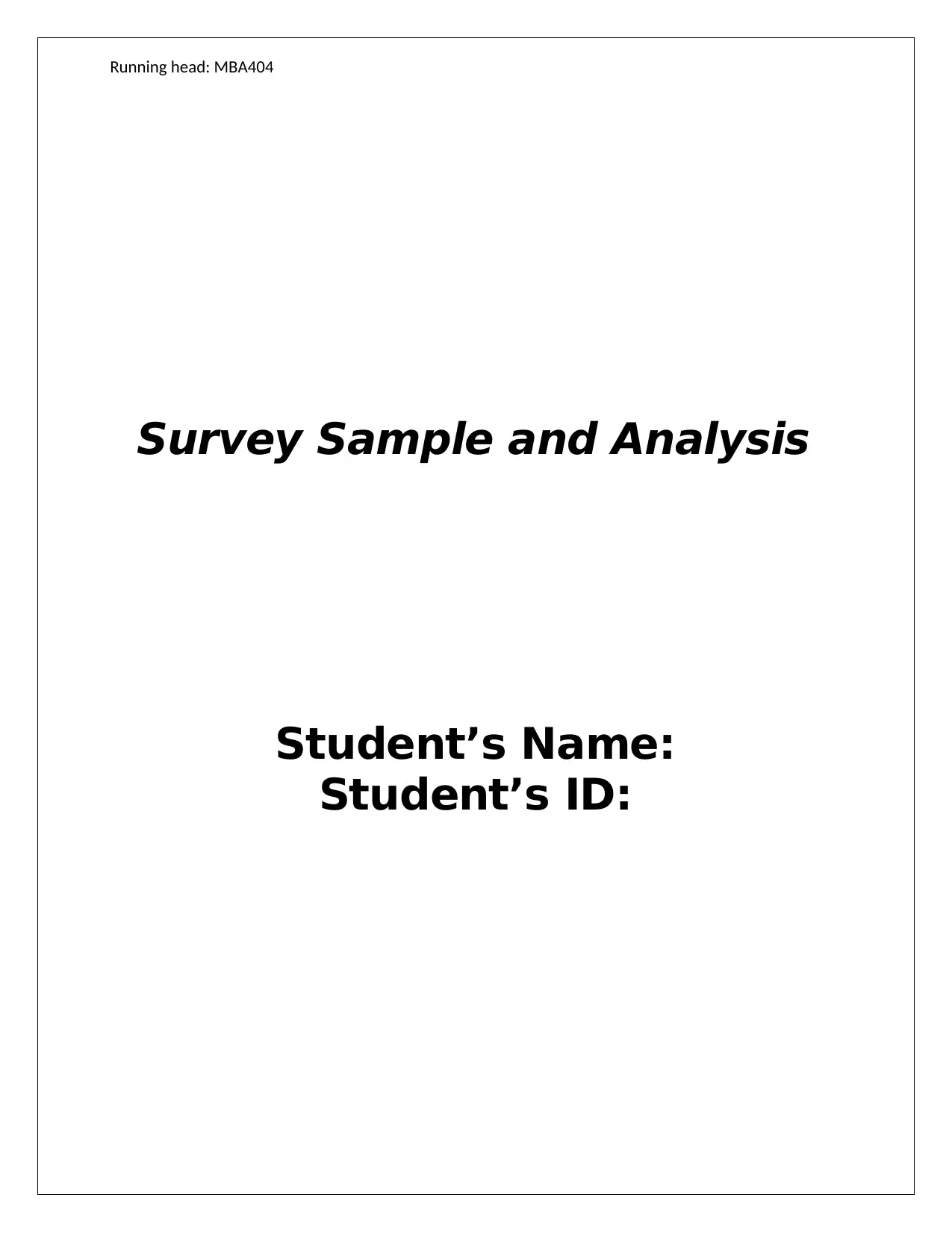
Running head: MBA404
Survey Sample and Analysis
Student’s Name:
Student’s ID:
Survey Sample and Analysis
Student’s Name:
Student’s ID:
Secure Best Marks with AI Grader
Need help grading? Try our AI Grader for instant feedback on your assignments.
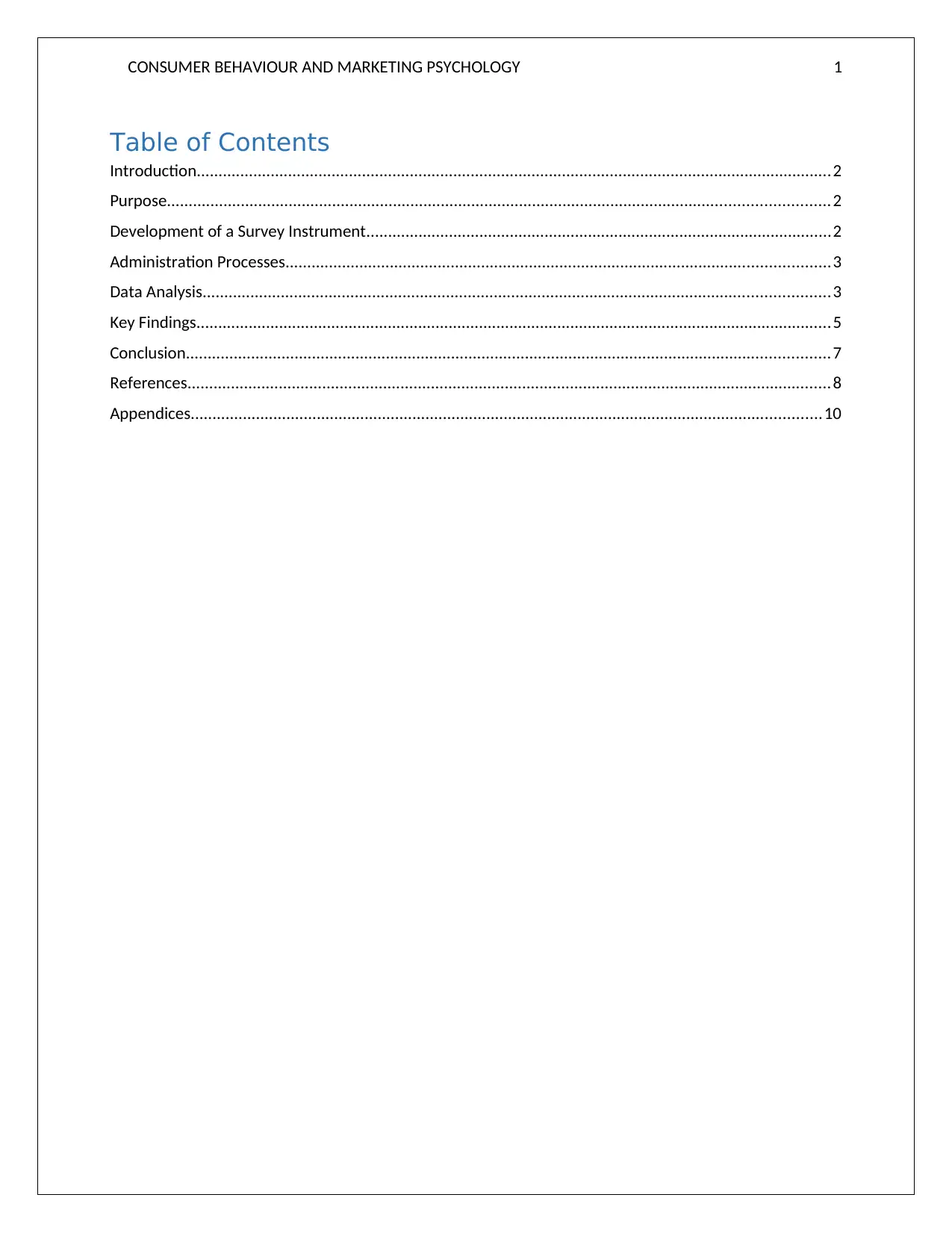
CONSUMER BEHAVIOUR AND MARKETING PSYCHOLOGY 1
Table of Contents
Introduction..................................................................................................................................................2
Purpose........................................................................................................................................................2
Development of a Survey Instrument...........................................................................................................2
Administration Processes.............................................................................................................................3
Data Analysis................................................................................................................................................3
Key Findings..................................................................................................................................................5
Conclusion....................................................................................................................................................7
References....................................................................................................................................................8
Appendices.................................................................................................................................................10
Table of Contents
Introduction..................................................................................................................................................2
Purpose........................................................................................................................................................2
Development of a Survey Instrument...........................................................................................................2
Administration Processes.............................................................................................................................3
Data Analysis................................................................................................................................................3
Key Findings..................................................................................................................................................5
Conclusion....................................................................................................................................................7
References....................................................................................................................................................8
Appendices.................................................................................................................................................10
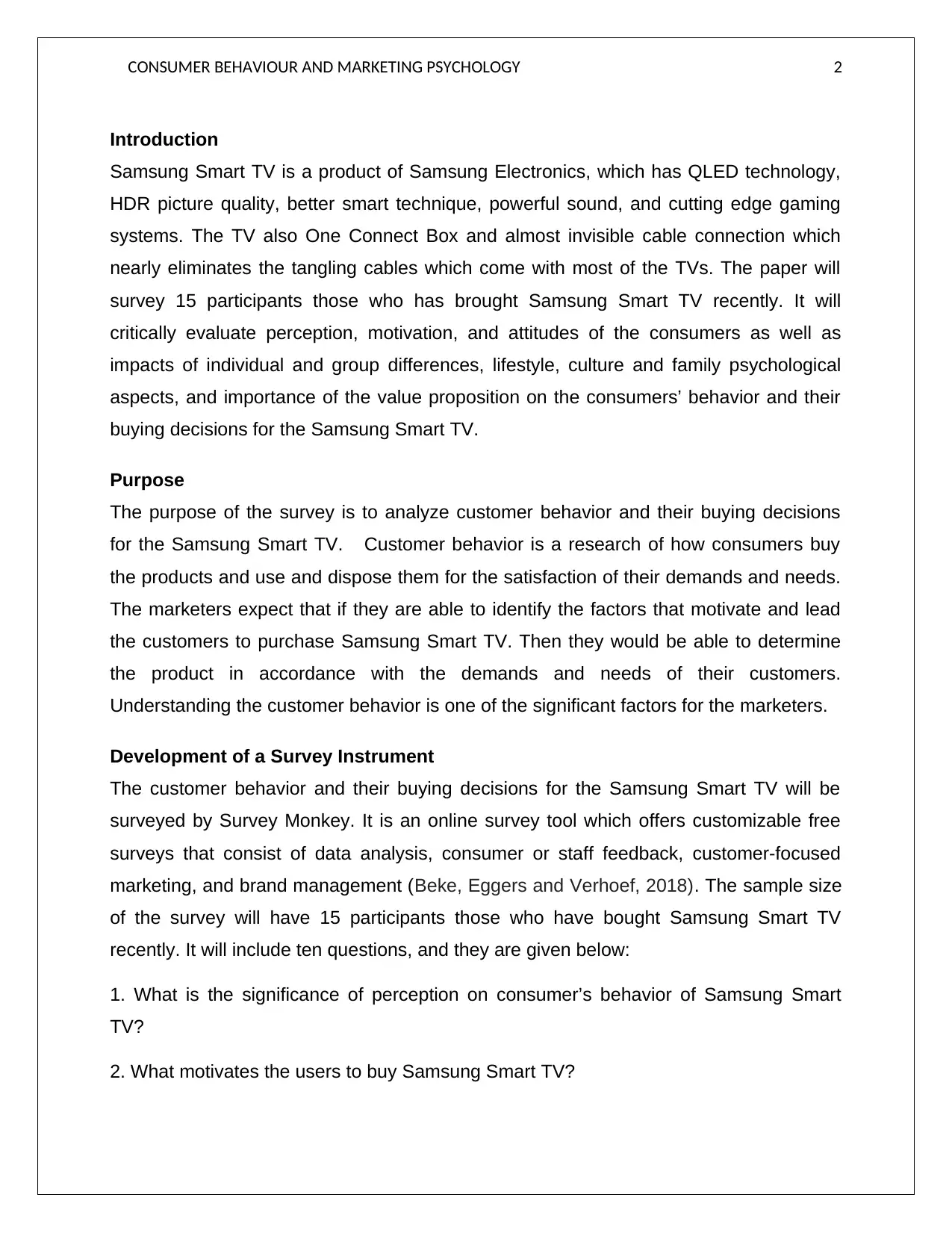
CONSUMER BEHAVIOUR AND MARKETING PSYCHOLOGY 2
Introduction
Samsung Smart TV is a product of Samsung Electronics, which has QLED technology,
HDR picture quality, better smart technique, powerful sound, and cutting edge gaming
systems. The TV also One Connect Box and almost invisible cable connection which
nearly eliminates the tangling cables which come with most of the TVs. The paper will
survey 15 participants those who has brought Samsung Smart TV recently. It will
critically evaluate perception, motivation, and attitudes of the consumers as well as
impacts of individual and group differences, lifestyle, culture and family psychological
aspects, and importance of the value proposition on the consumers’ behavior and their
buying decisions for the Samsung Smart TV.
Purpose
The purpose of the survey is to analyze customer behavior and their buying decisions
for the Samsung Smart TV. Customer behavior is a research of how consumers buy
the products and use and dispose them for the satisfaction of their demands and needs.
The marketers expect that if they are able to identify the factors that motivate and lead
the customers to purchase Samsung Smart TV. Then they would be able to determine
the product in accordance with the demands and needs of their customers.
Understanding the customer behavior is one of the significant factors for the marketers.
Development of a Survey Instrument
The customer behavior and their buying decisions for the Samsung Smart TV will be
surveyed by Survey Monkey. It is an online survey tool which offers customizable free
surveys that consist of data analysis, consumer or staff feedback, customer-focused
marketing, and brand management (Beke, Eggers and Verhoef, 2018). The sample size
of the survey will have 15 participants those who have bought Samsung Smart TV
recently. It will include ten questions, and they are given below:
1. What is the significance of perception on consumer’s behavior of Samsung Smart
TV?
2. What motivates the users to buy Samsung Smart TV?
Introduction
Samsung Smart TV is a product of Samsung Electronics, which has QLED technology,
HDR picture quality, better smart technique, powerful sound, and cutting edge gaming
systems. The TV also One Connect Box and almost invisible cable connection which
nearly eliminates the tangling cables which come with most of the TVs. The paper will
survey 15 participants those who has brought Samsung Smart TV recently. It will
critically evaluate perception, motivation, and attitudes of the consumers as well as
impacts of individual and group differences, lifestyle, culture and family psychological
aspects, and importance of the value proposition on the consumers’ behavior and their
buying decisions for the Samsung Smart TV.
Purpose
The purpose of the survey is to analyze customer behavior and their buying decisions
for the Samsung Smart TV. Customer behavior is a research of how consumers buy
the products and use and dispose them for the satisfaction of their demands and needs.
The marketers expect that if they are able to identify the factors that motivate and lead
the customers to purchase Samsung Smart TV. Then they would be able to determine
the product in accordance with the demands and needs of their customers.
Understanding the customer behavior is one of the significant factors for the marketers.
Development of a Survey Instrument
The customer behavior and their buying decisions for the Samsung Smart TV will be
surveyed by Survey Monkey. It is an online survey tool which offers customizable free
surveys that consist of data analysis, consumer or staff feedback, customer-focused
marketing, and brand management (Beke, Eggers and Verhoef, 2018). The sample size
of the survey will have 15 participants those who have bought Samsung Smart TV
recently. It will include ten questions, and they are given below:
1. What is the significance of perception on consumer’s behavior of Samsung Smart
TV?
2. What motivates the users to buy Samsung Smart TV?
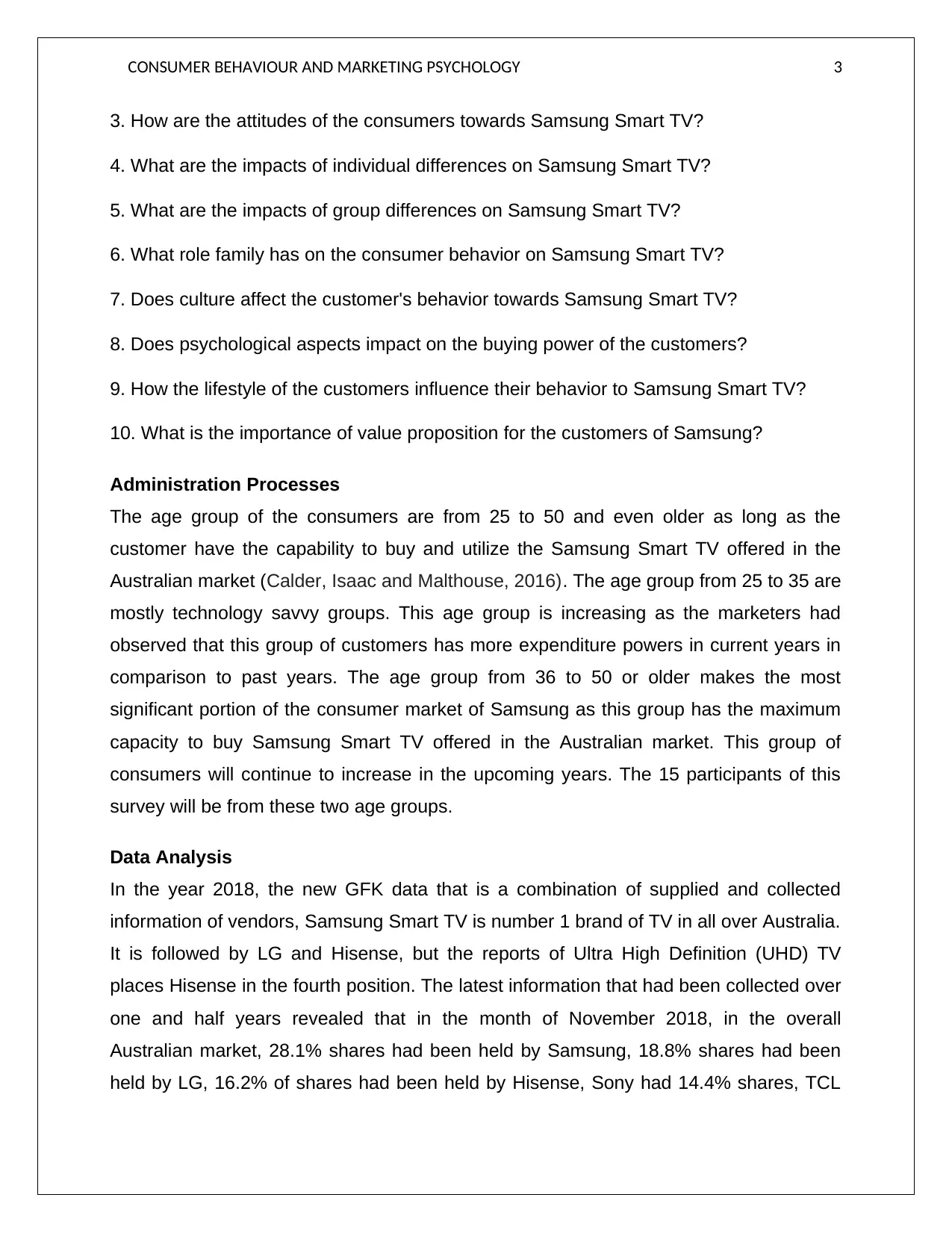
CONSUMER BEHAVIOUR AND MARKETING PSYCHOLOGY 3
3. How are the attitudes of the consumers towards Samsung Smart TV?
4. What are the impacts of individual differences on Samsung Smart TV?
5. What are the impacts of group differences on Samsung Smart TV?
6. What role family has on the consumer behavior on Samsung Smart TV?
7. Does culture affect the customer's behavior towards Samsung Smart TV?
8. Does psychological aspects impact on the buying power of the customers?
9. How the lifestyle of the customers influence their behavior to Samsung Smart TV?
10. What is the importance of value proposition for the customers of Samsung?
Administration Processes
The age group of the consumers are from 25 to 50 and even older as long as the
customer have the capability to buy and utilize the Samsung Smart TV offered in the
Australian market (Calder, Isaac and Malthouse, 2016). The age group from 25 to 35 are
mostly technology savvy groups. This age group is increasing as the marketers had
observed that this group of customers has more expenditure powers in current years in
comparison to past years. The age group from 36 to 50 or older makes the most
significant portion of the consumer market of Samsung as this group has the maximum
capacity to buy Samsung Smart TV offered in the Australian market. This group of
consumers will continue to increase in the upcoming years. The 15 participants of this
survey will be from these two age groups.
Data Analysis
In the year 2018, the new GFK data that is a combination of supplied and collected
information of vendors, Samsung Smart TV is number 1 brand of TV in all over Australia.
It is followed by LG and Hisense, but the reports of Ultra High Definition (UHD) TV
places Hisense in the fourth position. The latest information that had been collected over
one and half years revealed that in the month of November 2018, in the overall
Australian market, 28.1% shares had been held by Samsung, 18.8% shares had been
held by LG, 16.2% of shares had been held by Hisense, Sony had 14.4% shares, TCL
3. How are the attitudes of the consumers towards Samsung Smart TV?
4. What are the impacts of individual differences on Samsung Smart TV?
5. What are the impacts of group differences on Samsung Smart TV?
6. What role family has on the consumer behavior on Samsung Smart TV?
7. Does culture affect the customer's behavior towards Samsung Smart TV?
8. Does psychological aspects impact on the buying power of the customers?
9. How the lifestyle of the customers influence their behavior to Samsung Smart TV?
10. What is the importance of value proposition for the customers of Samsung?
Administration Processes
The age group of the consumers are from 25 to 50 and even older as long as the
customer have the capability to buy and utilize the Samsung Smart TV offered in the
Australian market (Calder, Isaac and Malthouse, 2016). The age group from 25 to 35 are
mostly technology savvy groups. This age group is increasing as the marketers had
observed that this group of customers has more expenditure powers in current years in
comparison to past years. The age group from 36 to 50 or older makes the most
significant portion of the consumer market of Samsung as this group has the maximum
capacity to buy Samsung Smart TV offered in the Australian market. This group of
consumers will continue to increase in the upcoming years. The 15 participants of this
survey will be from these two age groups.
Data Analysis
In the year 2018, the new GFK data that is a combination of supplied and collected
information of vendors, Samsung Smart TV is number 1 brand of TV in all over Australia.
It is followed by LG and Hisense, but the reports of Ultra High Definition (UHD) TV
places Hisense in the fourth position. The latest information that had been collected over
one and half years revealed that in the month of November 2018, in the overall
Australian market, 28.1% shares had been held by Samsung, 18.8% shares had been
held by LG, 16.2% of shares had been held by Hisense, Sony had 14.4% shares, TCL
Secure Best Marks with AI Grader
Need help grading? Try our AI Grader for instant feedback on your assignments.
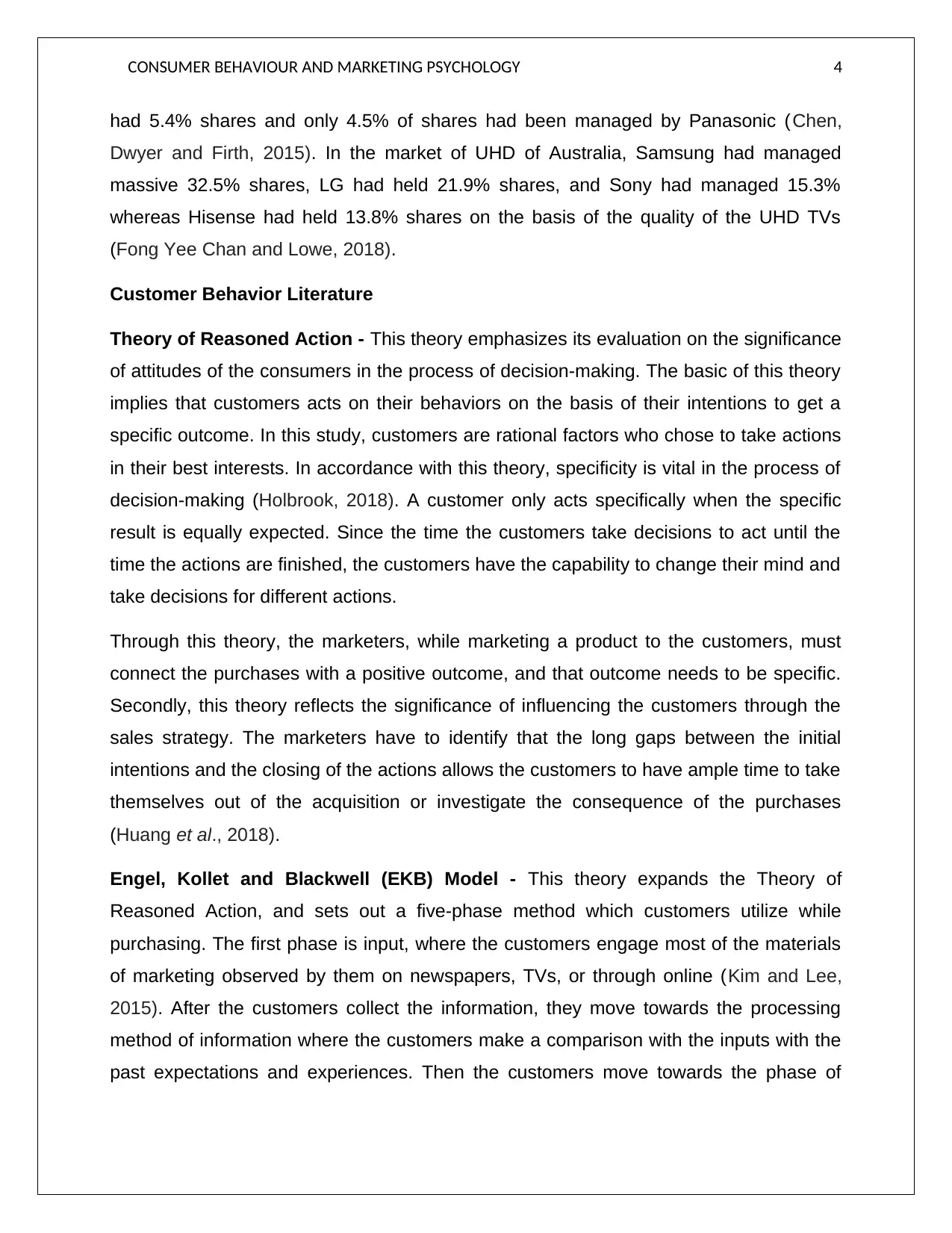
CONSUMER BEHAVIOUR AND MARKETING PSYCHOLOGY 4
had 5.4% shares and only 4.5% of shares had been managed by Panasonic ( Chen,
Dwyer and Firth, 2015). In the market of UHD of Australia, Samsung had managed
massive 32.5% shares, LG had held 21.9% shares, and Sony had managed 15.3%
whereas Hisense had held 13.8% shares on the basis of the quality of the UHD TVs
(Fong Yee Chan and Lowe, 2018).
Customer Behavior Literature
Theory of Reasoned Action - This theory emphasizes its evaluation on the significance
of attitudes of the consumers in the process of decision-making. The basic of this theory
implies that customers acts on their behaviors on the basis of their intentions to get a
specific outcome. In this study, customers are rational factors who chose to take actions
in their best interests. In accordance with this theory, specificity is vital in the process of
decision-making (Holbrook, 2018). A customer only acts specifically when the specific
result is equally expected. Since the time the customers take decisions to act until the
time the actions are finished, the customers have the capability to change their mind and
take decisions for different actions.
Through this theory, the marketers, while marketing a product to the customers, must
connect the purchases with a positive outcome, and that outcome needs to be specific.
Secondly, this theory reflects the significance of influencing the customers through the
sales strategy. The marketers have to identify that the long gaps between the initial
intentions and the closing of the actions allows the customers to have ample time to take
themselves out of the acquisition or investigate the consequence of the purchases
(Huang et al., 2018).
Engel, Kollet and Blackwell (EKB) Model - This theory expands the Theory of
Reasoned Action, and sets out a five-phase method which customers utilize while
purchasing. The first phase is input, where the customers engage most of the materials
of marketing observed by them on newspapers, TVs, or through online (Kim and Lee,
2015). After the customers collect the information, they move towards the processing
method of information where the customers make a comparison with the inputs with the
past expectations and experiences. Then the customers move towards the phase of
had 5.4% shares and only 4.5% of shares had been managed by Panasonic ( Chen,
Dwyer and Firth, 2015). In the market of UHD of Australia, Samsung had managed
massive 32.5% shares, LG had held 21.9% shares, and Sony had managed 15.3%
whereas Hisense had held 13.8% shares on the basis of the quality of the UHD TVs
(Fong Yee Chan and Lowe, 2018).
Customer Behavior Literature
Theory of Reasoned Action - This theory emphasizes its evaluation on the significance
of attitudes of the consumers in the process of decision-making. The basic of this theory
implies that customers acts on their behaviors on the basis of their intentions to get a
specific outcome. In this study, customers are rational factors who chose to take actions
in their best interests. In accordance with this theory, specificity is vital in the process of
decision-making (Holbrook, 2018). A customer only acts specifically when the specific
result is equally expected. Since the time the customers take decisions to act until the
time the actions are finished, the customers have the capability to change their mind and
take decisions for different actions.
Through this theory, the marketers, while marketing a product to the customers, must
connect the purchases with a positive outcome, and that outcome needs to be specific.
Secondly, this theory reflects the significance of influencing the customers through the
sales strategy. The marketers have to identify that the long gaps between the initial
intentions and the closing of the actions allows the customers to have ample time to take
themselves out of the acquisition or investigate the consequence of the purchases
(Huang et al., 2018).
Engel, Kollet and Blackwell (EKB) Model - This theory expands the Theory of
Reasoned Action, and sets out a five-phase method which customers utilize while
purchasing. The first phase is input, where the customers engage most of the materials
of marketing observed by them on newspapers, TVs, or through online (Kim and Lee,
2015). After the customers collect the information, they move towards the processing
method of information where the customers make a comparison with the inputs with the
past expectations and experiences. Then the customers move towards the phase of
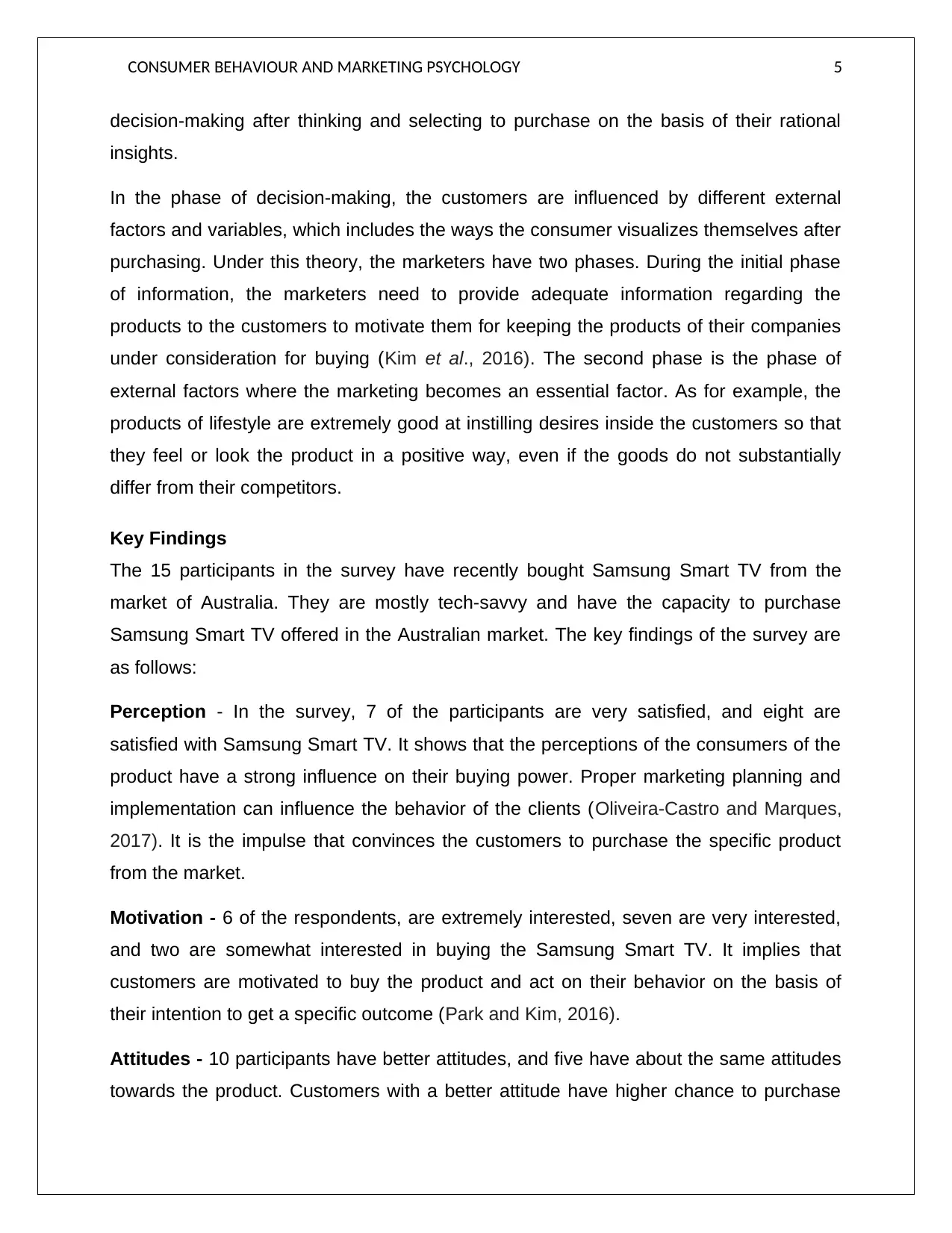
CONSUMER BEHAVIOUR AND MARKETING PSYCHOLOGY 5
decision-making after thinking and selecting to purchase on the basis of their rational
insights.
In the phase of decision-making, the customers are influenced by different external
factors and variables, which includes the ways the consumer visualizes themselves after
purchasing. Under this theory, the marketers have two phases. During the initial phase
of information, the marketers need to provide adequate information regarding the
products to the customers to motivate them for keeping the products of their companies
under consideration for buying (Kim et al., 2016). The second phase is the phase of
external factors where the marketing becomes an essential factor. As for example, the
products of lifestyle are extremely good at instilling desires inside the customers so that
they feel or look the product in a positive way, even if the goods do not substantially
differ from their competitors.
Key Findings
The 15 participants in the survey have recently bought Samsung Smart TV from the
market of Australia. They are mostly tech-savvy and have the capacity to purchase
Samsung Smart TV offered in the Australian market. The key findings of the survey are
as follows:
Perception - In the survey, 7 of the participants are very satisfied, and eight are
satisfied with Samsung Smart TV. It shows that the perceptions of the consumers of the
product have a strong influence on their buying power. Proper marketing planning and
implementation can influence the behavior of the clients (Oliveira-Castro and Marques,
2017). It is the impulse that convinces the customers to purchase the specific product
from the market.
Motivation - 6 of the respondents, are extremely interested, seven are very interested,
and two are somewhat interested in buying the Samsung Smart TV. It implies that
customers are motivated to buy the product and act on their behavior on the basis of
their intention to get a specific outcome (Park and Kim, 2016).
Attitudes - 10 participants have better attitudes, and five have about the same attitudes
towards the product. Customers with a better attitude have higher chance to purchase
decision-making after thinking and selecting to purchase on the basis of their rational
insights.
In the phase of decision-making, the customers are influenced by different external
factors and variables, which includes the ways the consumer visualizes themselves after
purchasing. Under this theory, the marketers have two phases. During the initial phase
of information, the marketers need to provide adequate information regarding the
products to the customers to motivate them for keeping the products of their companies
under consideration for buying (Kim et al., 2016). The second phase is the phase of
external factors where the marketing becomes an essential factor. As for example, the
products of lifestyle are extremely good at instilling desires inside the customers so that
they feel or look the product in a positive way, even if the goods do not substantially
differ from their competitors.
Key Findings
The 15 participants in the survey have recently bought Samsung Smart TV from the
market of Australia. They are mostly tech-savvy and have the capacity to purchase
Samsung Smart TV offered in the Australian market. The key findings of the survey are
as follows:
Perception - In the survey, 7 of the participants are very satisfied, and eight are
satisfied with Samsung Smart TV. It shows that the perceptions of the consumers of the
product have a strong influence on their buying power. Proper marketing planning and
implementation can influence the behavior of the clients (Oliveira-Castro and Marques,
2017). It is the impulse that convinces the customers to purchase the specific product
from the market.
Motivation - 6 of the respondents, are extremely interested, seven are very interested,
and two are somewhat interested in buying the Samsung Smart TV. It implies that
customers are motivated to buy the product and act on their behavior on the basis of
their intention to get a specific outcome (Park and Kim, 2016).
Attitudes - 10 participants have better attitudes, and five have about the same attitudes
towards the product. Customers with a better attitude have higher chance to purchase
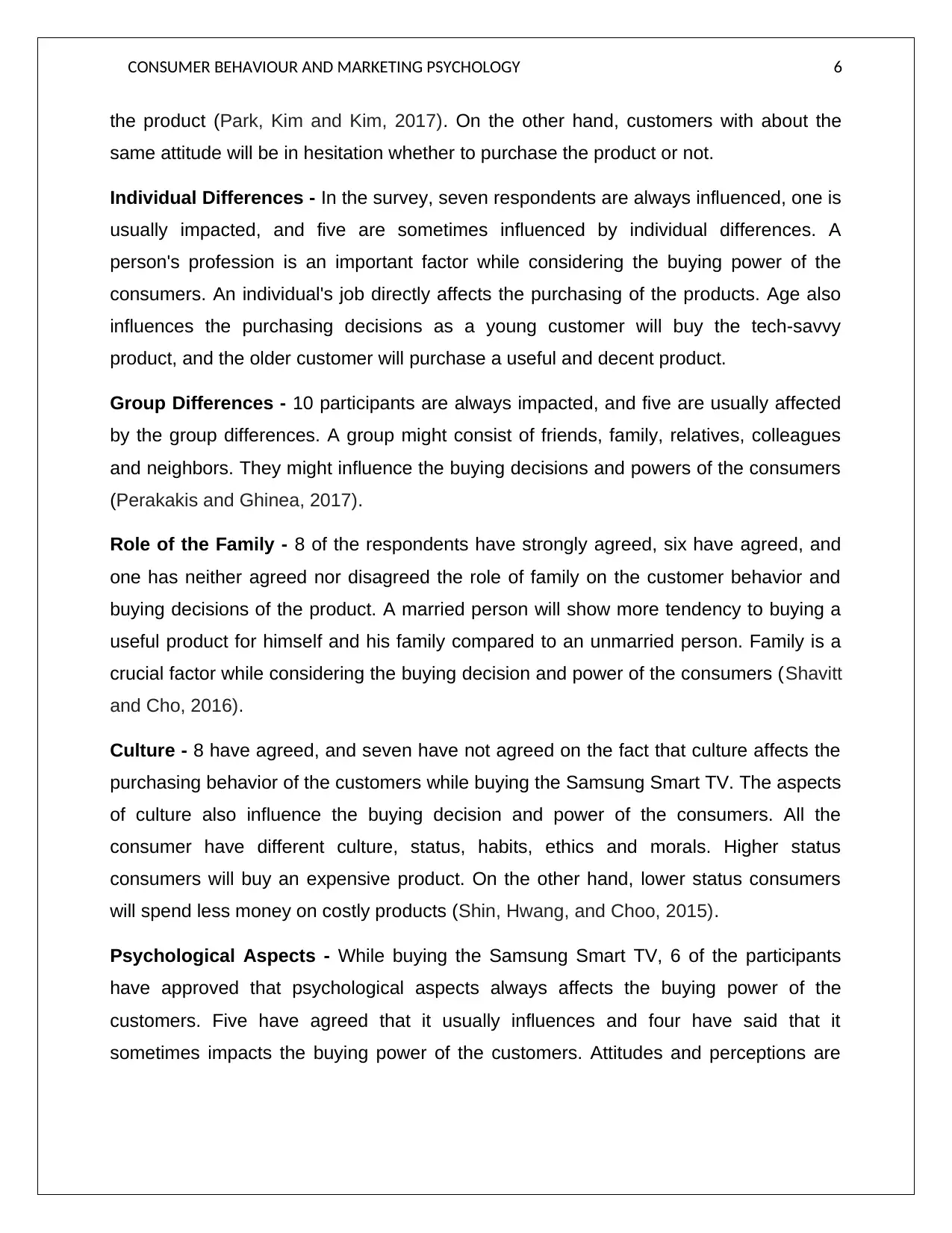
CONSUMER BEHAVIOUR AND MARKETING PSYCHOLOGY 6
the product (Park, Kim and Kim, 2017). On the other hand, customers with about the
same attitude will be in hesitation whether to purchase the product or not.
Individual Differences - In the survey, seven respondents are always influenced, one is
usually impacted, and five are sometimes influenced by individual differences. A
person's profession is an important factor while considering the buying power of the
consumers. An individual's job directly affects the purchasing of the products. Age also
influences the purchasing decisions as a young customer will buy the tech-savvy
product, and the older customer will purchase a useful and decent product.
Group Differences - 10 participants are always impacted, and five are usually affected
by the group differences. A group might consist of friends, family, relatives, colleagues
and neighbors. They might influence the buying decisions and powers of the consumers
(Perakakis and Ghinea, 2017).
Role of the Family - 8 of the respondents have strongly agreed, six have agreed, and
one has neither agreed nor disagreed the role of family on the customer behavior and
buying decisions of the product. A married person will show more tendency to buying a
useful product for himself and his family compared to an unmarried person. Family is a
crucial factor while considering the buying decision and power of the consumers (Shavitt
and Cho, 2016).
Culture - 8 have agreed, and seven have not agreed on the fact that culture affects the
purchasing behavior of the customers while buying the Samsung Smart TV. The aspects
of culture also influence the buying decision and power of the consumers. All the
consumer have different culture, status, habits, ethics and morals. Higher status
consumers will buy an expensive product. On the other hand, lower status consumers
will spend less money on costly products (Shin, Hwang, and Choo, 2015).
Psychological Aspects - While buying the Samsung Smart TV, 6 of the participants
have approved that psychological aspects always affects the buying power of the
customers. Five have agreed that it usually influences and four have said that it
sometimes impacts the buying power of the customers. Attitudes and perceptions are
the product (Park, Kim and Kim, 2017). On the other hand, customers with about the
same attitude will be in hesitation whether to purchase the product or not.
Individual Differences - In the survey, seven respondents are always influenced, one is
usually impacted, and five are sometimes influenced by individual differences. A
person's profession is an important factor while considering the buying power of the
consumers. An individual's job directly affects the purchasing of the products. Age also
influences the purchasing decisions as a young customer will buy the tech-savvy
product, and the older customer will purchase a useful and decent product.
Group Differences - 10 participants are always impacted, and five are usually affected
by the group differences. A group might consist of friends, family, relatives, colleagues
and neighbors. They might influence the buying decisions and powers of the consumers
(Perakakis and Ghinea, 2017).
Role of the Family - 8 of the respondents have strongly agreed, six have agreed, and
one has neither agreed nor disagreed the role of family on the customer behavior and
buying decisions of the product. A married person will show more tendency to buying a
useful product for himself and his family compared to an unmarried person. Family is a
crucial factor while considering the buying decision and power of the consumers (Shavitt
and Cho, 2016).
Culture - 8 have agreed, and seven have not agreed on the fact that culture affects the
purchasing behavior of the customers while buying the Samsung Smart TV. The aspects
of culture also influence the buying decision and power of the consumers. All the
consumer have different culture, status, habits, ethics and morals. Higher status
consumers will buy an expensive product. On the other hand, lower status consumers
will spend less money on costly products (Shin, Hwang, and Choo, 2015).
Psychological Aspects - While buying the Samsung Smart TV, 6 of the participants
have approved that psychological aspects always affects the buying power of the
customers. Five have agreed that it usually influences and four have said that it
sometimes impacts the buying power of the customers. Attitudes and perceptions are
Paraphrase This Document
Need a fresh take? Get an instant paraphrase of this document with our AI Paraphraser
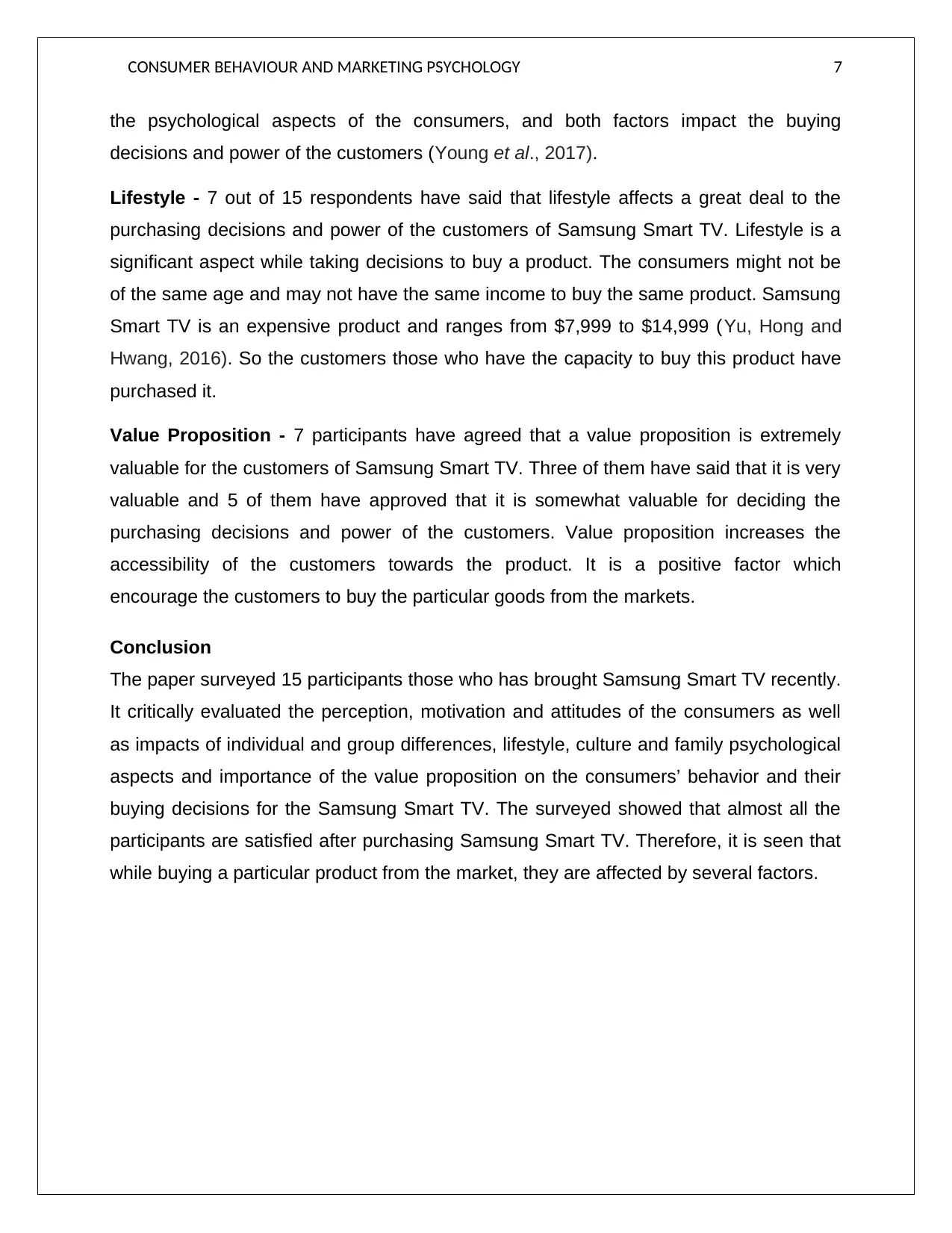
CONSUMER BEHAVIOUR AND MARKETING PSYCHOLOGY 7
the psychological aspects of the consumers, and both factors impact the buying
decisions and power of the customers (Young et al., 2017).
Lifestyle - 7 out of 15 respondents have said that lifestyle affects a great deal to the
purchasing decisions and power of the customers of Samsung Smart TV. Lifestyle is a
significant aspect while taking decisions to buy a product. The consumers might not be
of the same age and may not have the same income to buy the same product. Samsung
Smart TV is an expensive product and ranges from $7,999 to $14,999 (Yu, Hong and
Hwang, 2016). So the customers those who have the capacity to buy this product have
purchased it.
Value Proposition - 7 participants have agreed that a value proposition is extremely
valuable for the customers of Samsung Smart TV. Three of them have said that it is very
valuable and 5 of them have approved that it is somewhat valuable for deciding the
purchasing decisions and power of the customers. Value proposition increases the
accessibility of the customers towards the product. It is a positive factor which
encourage the customers to buy the particular goods from the markets.
Conclusion
The paper surveyed 15 participants those who has brought Samsung Smart TV recently.
It critically evaluated the perception, motivation and attitudes of the consumers as well
as impacts of individual and group differences, lifestyle, culture and family psychological
aspects and importance of the value proposition on the consumers’ behavior and their
buying decisions for the Samsung Smart TV. The surveyed showed that almost all the
participants are satisfied after purchasing Samsung Smart TV. Therefore, it is seen that
while buying a particular product from the market, they are affected by several factors.
the psychological aspects of the consumers, and both factors impact the buying
decisions and power of the customers (Young et al., 2017).
Lifestyle - 7 out of 15 respondents have said that lifestyle affects a great deal to the
purchasing decisions and power of the customers of Samsung Smart TV. Lifestyle is a
significant aspect while taking decisions to buy a product. The consumers might not be
of the same age and may not have the same income to buy the same product. Samsung
Smart TV is an expensive product and ranges from $7,999 to $14,999 (Yu, Hong and
Hwang, 2016). So the customers those who have the capacity to buy this product have
purchased it.
Value Proposition - 7 participants have agreed that a value proposition is extremely
valuable for the customers of Samsung Smart TV. Three of them have said that it is very
valuable and 5 of them have approved that it is somewhat valuable for deciding the
purchasing decisions and power of the customers. Value proposition increases the
accessibility of the customers towards the product. It is a positive factor which
encourage the customers to buy the particular goods from the markets.
Conclusion
The paper surveyed 15 participants those who has brought Samsung Smart TV recently.
It critically evaluated the perception, motivation and attitudes of the consumers as well
as impacts of individual and group differences, lifestyle, culture and family psychological
aspects and importance of the value proposition on the consumers’ behavior and their
buying decisions for the Samsung Smart TV. The surveyed showed that almost all the
participants are satisfied after purchasing Samsung Smart TV. Therefore, it is seen that
while buying a particular product from the market, they are affected by several factors.
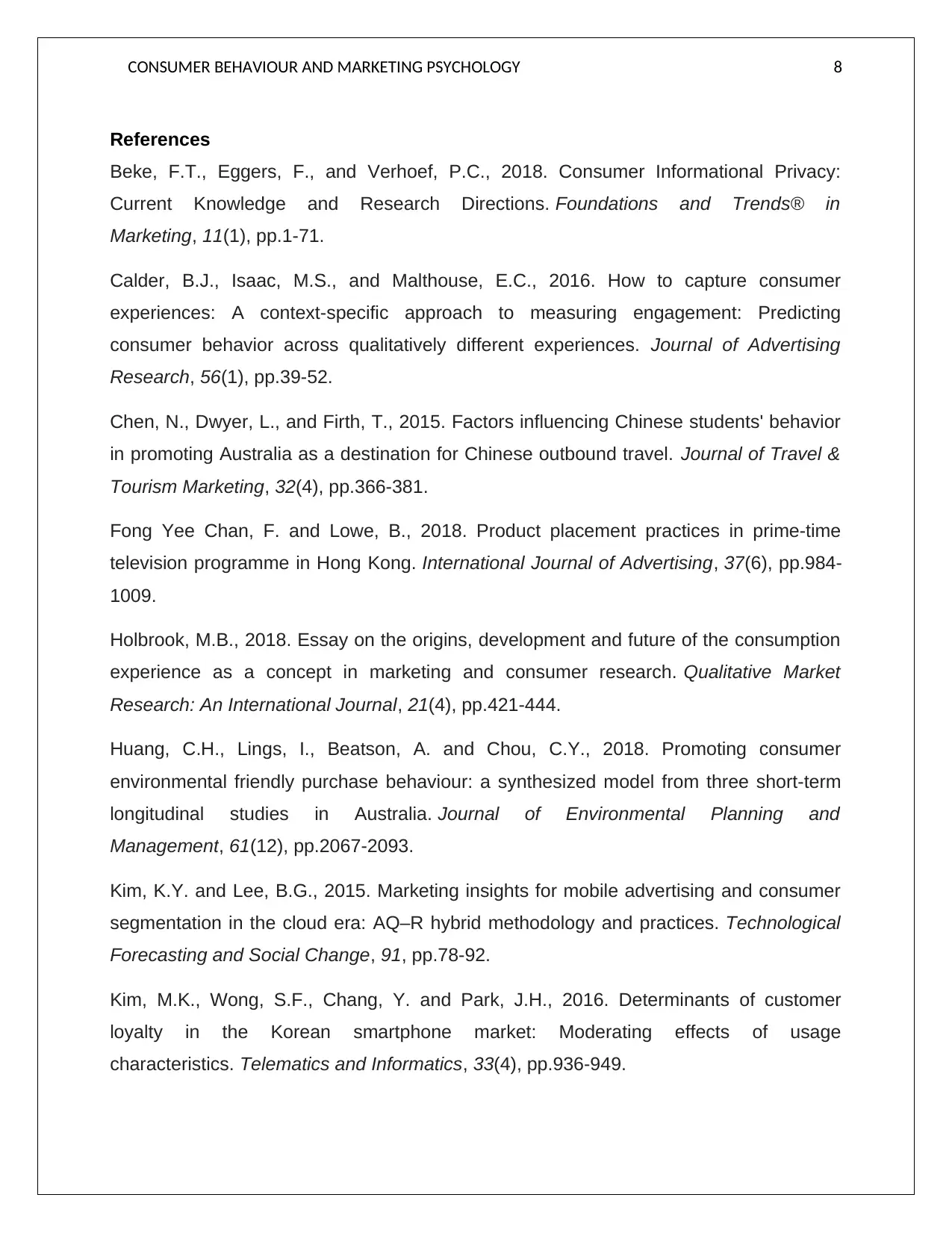
CONSUMER BEHAVIOUR AND MARKETING PSYCHOLOGY 8
References
Beke, F.T., Eggers, F., and Verhoef, P.C., 2018. Consumer Informational Privacy:
Current Knowledge and Research Directions. Foundations and Trends® in
Marketing, 11(1), pp.1-71.
Calder, B.J., Isaac, M.S., and Malthouse, E.C., 2016. How to capture consumer
experiences: A context-specific approach to measuring engagement: Predicting
consumer behavior across qualitatively different experiences. Journal of Advertising
Research, 56(1), pp.39-52.
Chen, N., Dwyer, L., and Firth, T., 2015. Factors influencing Chinese students' behavior
in promoting Australia as a destination for Chinese outbound travel. Journal of Travel &
Tourism Marketing, 32(4), pp.366-381.
Fong Yee Chan, F. and Lowe, B., 2018. Product placement practices in prime-time
television programme in Hong Kong. International Journal of Advertising, 37(6), pp.984-
1009.
Holbrook, M.B., 2018. Essay on the origins, development and future of the consumption
experience as a concept in marketing and consumer research. Qualitative Market
Research: An International Journal, 21(4), pp.421-444.
Huang, C.H., Lings, I., Beatson, A. and Chou, C.Y., 2018. Promoting consumer
environmental friendly purchase behaviour: a synthesized model from three short-term
longitudinal studies in Australia. Journal of Environmental Planning and
Management, 61(12), pp.2067-2093.
Kim, K.Y. and Lee, B.G., 2015. Marketing insights for mobile advertising and consumer
segmentation in the cloud era: AQ–R hybrid methodology and practices. Technological
Forecasting and Social Change, 91, pp.78-92.
Kim, M.K., Wong, S.F., Chang, Y. and Park, J.H., 2016. Determinants of customer
loyalty in the Korean smartphone market: Moderating effects of usage
characteristics. Telematics and Informatics, 33(4), pp.936-949.
References
Beke, F.T., Eggers, F., and Verhoef, P.C., 2018. Consumer Informational Privacy:
Current Knowledge and Research Directions. Foundations and Trends® in
Marketing, 11(1), pp.1-71.
Calder, B.J., Isaac, M.S., and Malthouse, E.C., 2016. How to capture consumer
experiences: A context-specific approach to measuring engagement: Predicting
consumer behavior across qualitatively different experiences. Journal of Advertising
Research, 56(1), pp.39-52.
Chen, N., Dwyer, L., and Firth, T., 2015. Factors influencing Chinese students' behavior
in promoting Australia as a destination for Chinese outbound travel. Journal of Travel &
Tourism Marketing, 32(4), pp.366-381.
Fong Yee Chan, F. and Lowe, B., 2018. Product placement practices in prime-time
television programme in Hong Kong. International Journal of Advertising, 37(6), pp.984-
1009.
Holbrook, M.B., 2018. Essay on the origins, development and future of the consumption
experience as a concept in marketing and consumer research. Qualitative Market
Research: An International Journal, 21(4), pp.421-444.
Huang, C.H., Lings, I., Beatson, A. and Chou, C.Y., 2018. Promoting consumer
environmental friendly purchase behaviour: a synthesized model from three short-term
longitudinal studies in Australia. Journal of Environmental Planning and
Management, 61(12), pp.2067-2093.
Kim, K.Y. and Lee, B.G., 2015. Marketing insights for mobile advertising and consumer
segmentation in the cloud era: AQ–R hybrid methodology and practices. Technological
Forecasting and Social Change, 91, pp.78-92.
Kim, M.K., Wong, S.F., Chang, Y. and Park, J.H., 2016. Determinants of customer
loyalty in the Korean smartphone market: Moderating effects of usage
characteristics. Telematics and Informatics, 33(4), pp.936-949.
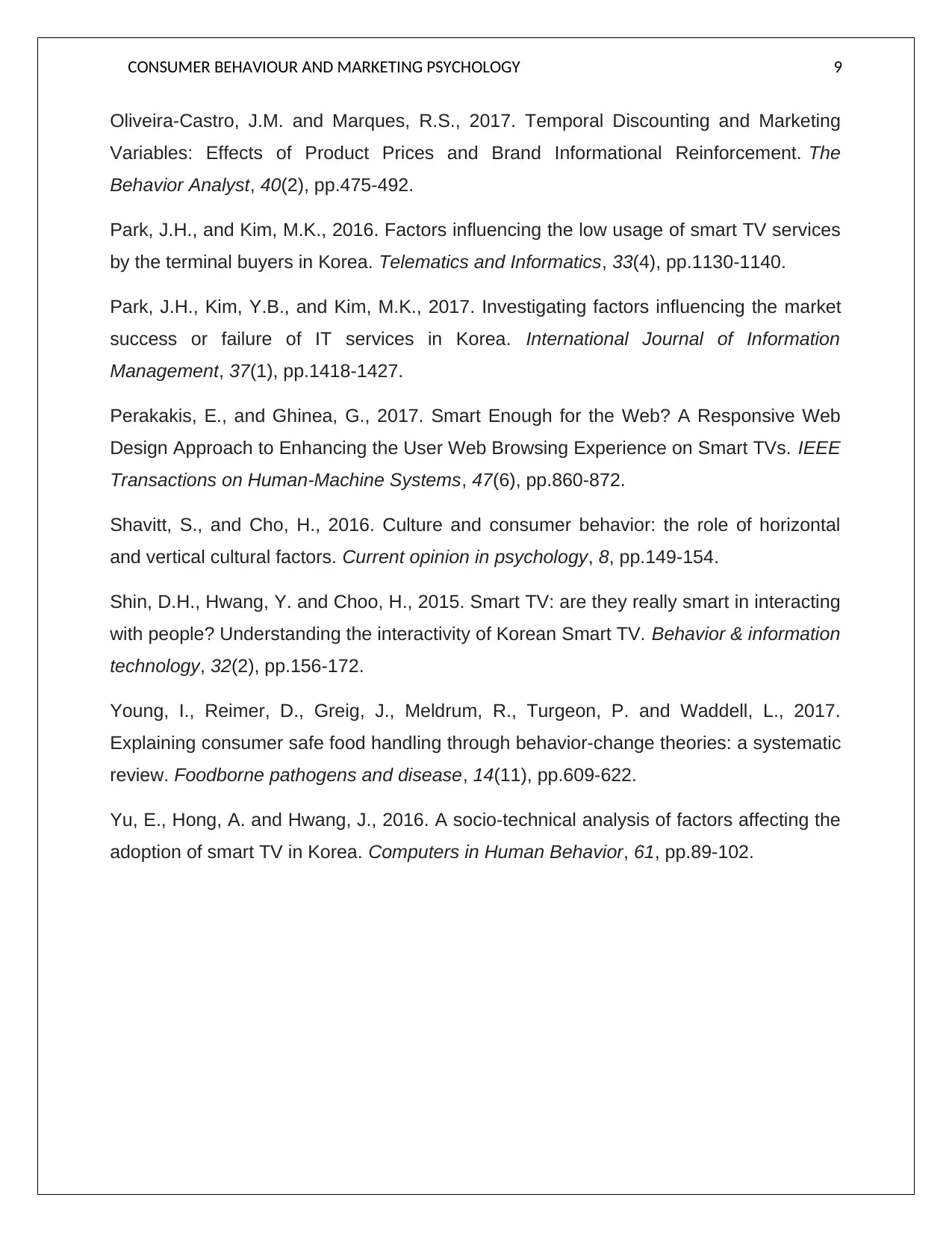
CONSUMER BEHAVIOUR AND MARKETING PSYCHOLOGY 9
Oliveira-Castro, J.M. and Marques, R.S., 2017. Temporal Discounting and Marketing
Variables: Effects of Product Prices and Brand Informational Reinforcement. The
Behavior Analyst, 40(2), pp.475-492.
Park, J.H., and Kim, M.K., 2016. Factors influencing the low usage of smart TV services
by the terminal buyers in Korea. Telematics and Informatics, 33(4), pp.1130-1140.
Park, J.H., Kim, Y.B., and Kim, M.K., 2017. Investigating factors influencing the market
success or failure of IT services in Korea. International Journal of Information
Management, 37(1), pp.1418-1427.
Perakakis, E., and Ghinea, G., 2017. Smart Enough for the Web? A Responsive Web
Design Approach to Enhancing the User Web Browsing Experience on Smart TVs. IEEE
Transactions on Human-Machine Systems, 47(6), pp.860-872.
Shavitt, S., and Cho, H., 2016. Culture and consumer behavior: the role of horizontal
and vertical cultural factors. Current opinion in psychology, 8, pp.149-154.
Shin, D.H., Hwang, Y. and Choo, H., 2015. Smart TV: are they really smart in interacting
with people? Understanding the interactivity of Korean Smart TV. Behavior & information
technology, 32(2), pp.156-172.
Young, I., Reimer, D., Greig, J., Meldrum, R., Turgeon, P. and Waddell, L., 2017.
Explaining consumer safe food handling through behavior-change theories: a systematic
review. Foodborne pathogens and disease, 14(11), pp.609-622.
Yu, E., Hong, A. and Hwang, J., 2016. A socio-technical analysis of factors affecting the
adoption of smart TV in Korea. Computers in Human Behavior, 61, pp.89-102.
Oliveira-Castro, J.M. and Marques, R.S., 2017. Temporal Discounting and Marketing
Variables: Effects of Product Prices and Brand Informational Reinforcement. The
Behavior Analyst, 40(2), pp.475-492.
Park, J.H., and Kim, M.K., 2016. Factors influencing the low usage of smart TV services
by the terminal buyers in Korea. Telematics and Informatics, 33(4), pp.1130-1140.
Park, J.H., Kim, Y.B., and Kim, M.K., 2017. Investigating factors influencing the market
success or failure of IT services in Korea. International Journal of Information
Management, 37(1), pp.1418-1427.
Perakakis, E., and Ghinea, G., 2017. Smart Enough for the Web? A Responsive Web
Design Approach to Enhancing the User Web Browsing Experience on Smart TVs. IEEE
Transactions on Human-Machine Systems, 47(6), pp.860-872.
Shavitt, S., and Cho, H., 2016. Culture and consumer behavior: the role of horizontal
and vertical cultural factors. Current opinion in psychology, 8, pp.149-154.
Shin, D.H., Hwang, Y. and Choo, H., 2015. Smart TV: are they really smart in interacting
with people? Understanding the interactivity of Korean Smart TV. Behavior & information
technology, 32(2), pp.156-172.
Young, I., Reimer, D., Greig, J., Meldrum, R., Turgeon, P. and Waddell, L., 2017.
Explaining consumer safe food handling through behavior-change theories: a systematic
review. Foodborne pathogens and disease, 14(11), pp.609-622.
Yu, E., Hong, A. and Hwang, J., 2016. A socio-technical analysis of factors affecting the
adoption of smart TV in Korea. Computers in Human Behavior, 61, pp.89-102.
Secure Best Marks with AI Grader
Need help grading? Try our AI Grader for instant feedback on your assignments.
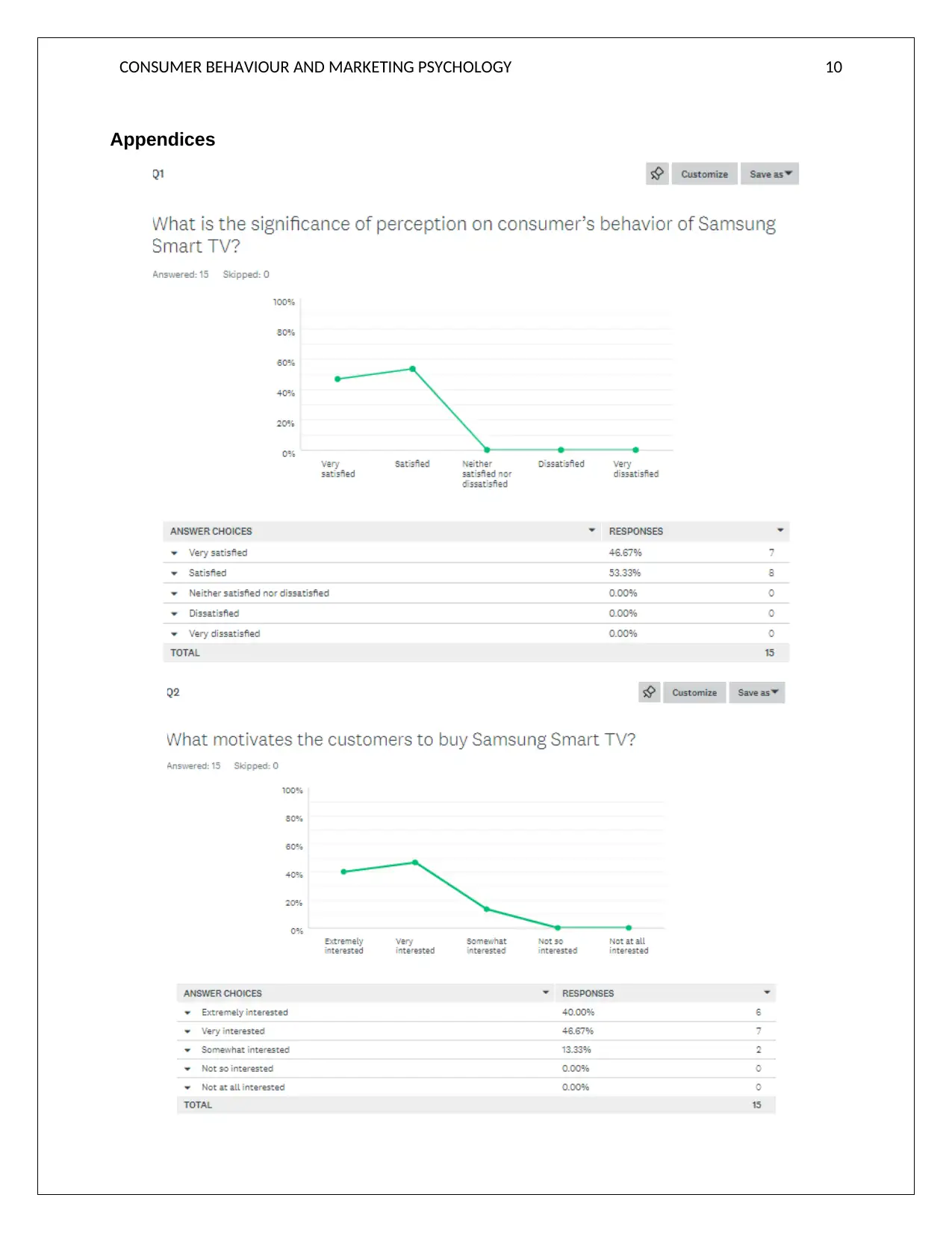
CONSUMER BEHAVIOUR AND MARKETING PSYCHOLOGY 10
Appendices
Appendices
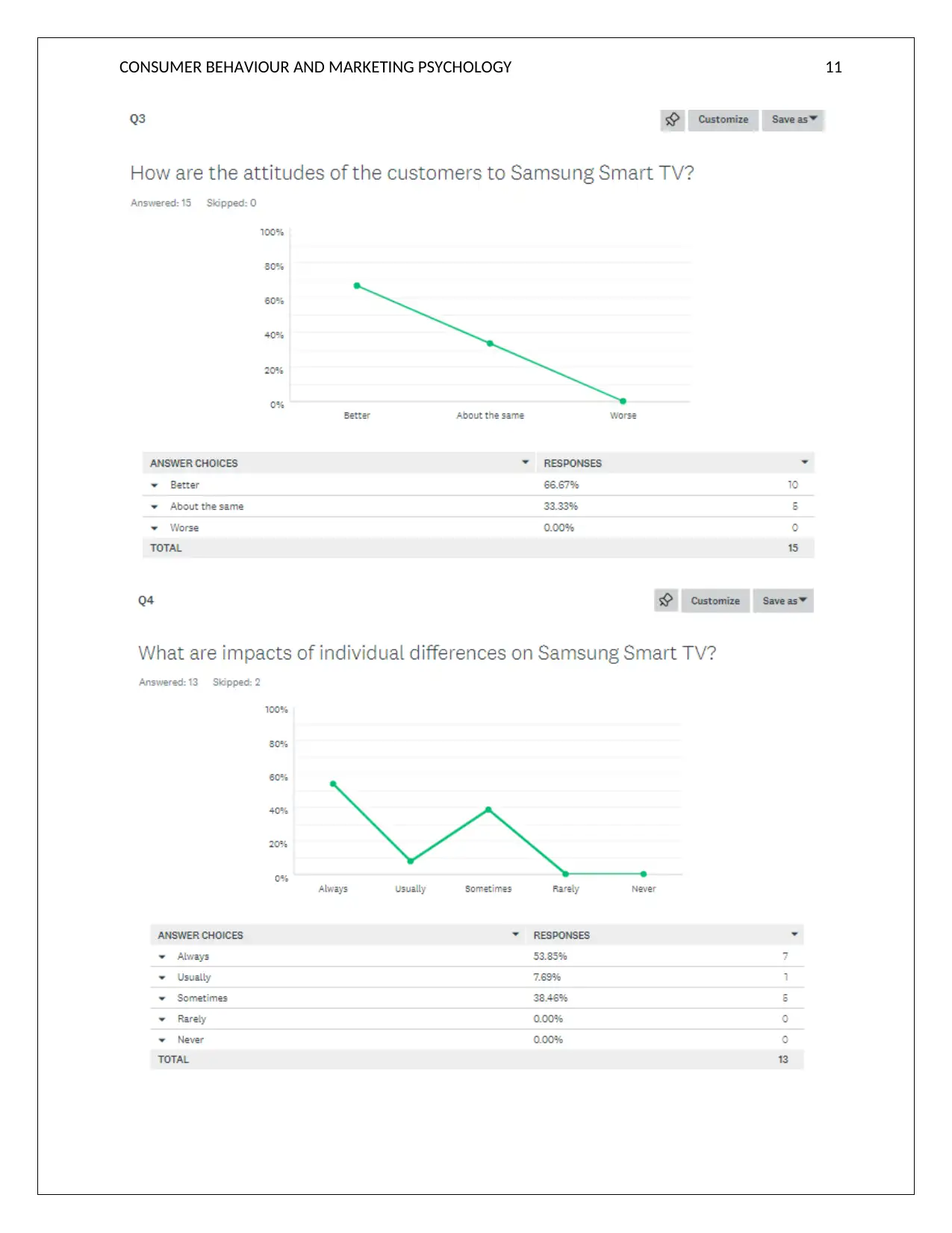
CONSUMER BEHAVIOUR AND MARKETING PSYCHOLOGY 11
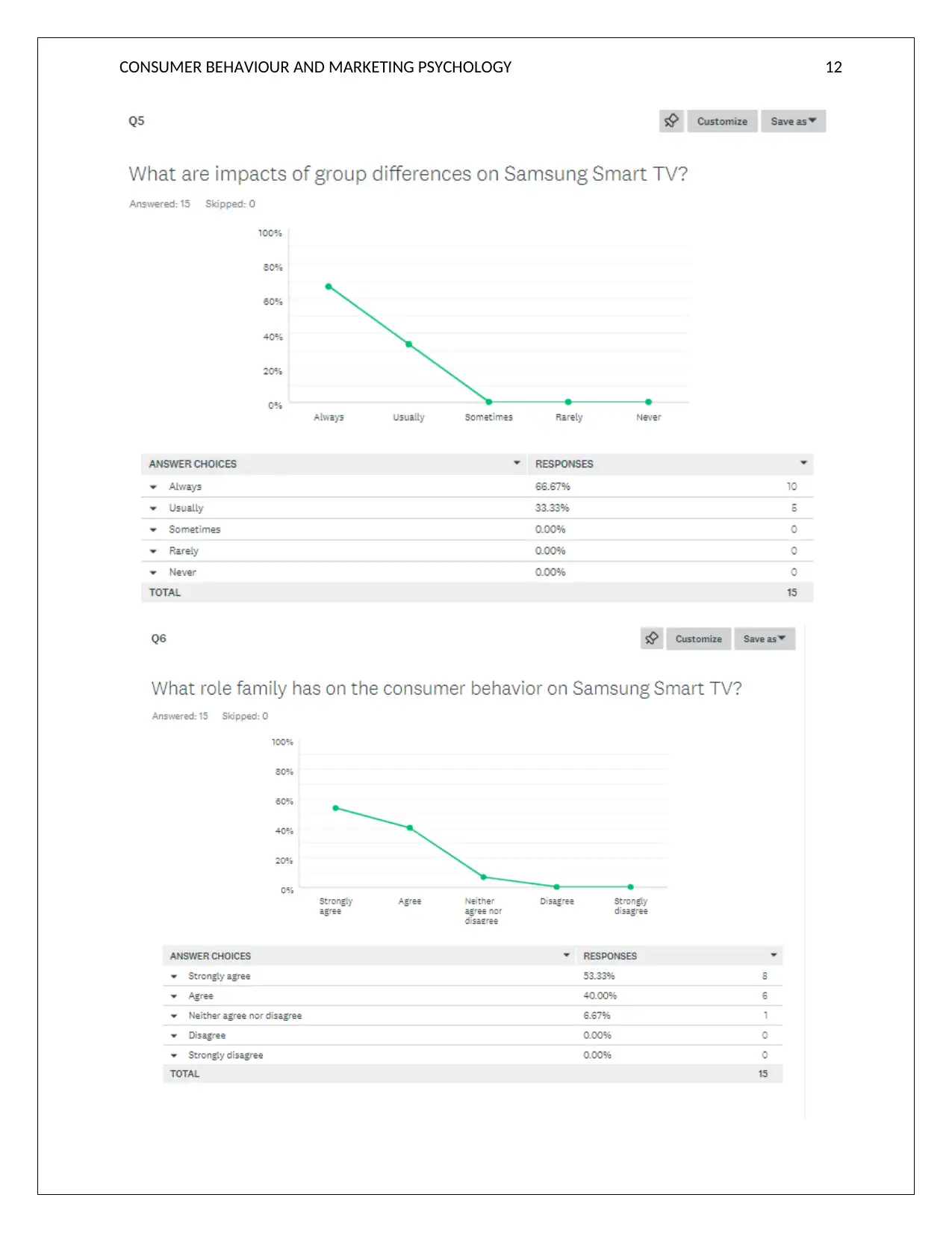
CONSUMER BEHAVIOUR AND MARKETING PSYCHOLOGY 12
Paraphrase This Document
Need a fresh take? Get an instant paraphrase of this document with our AI Paraphraser
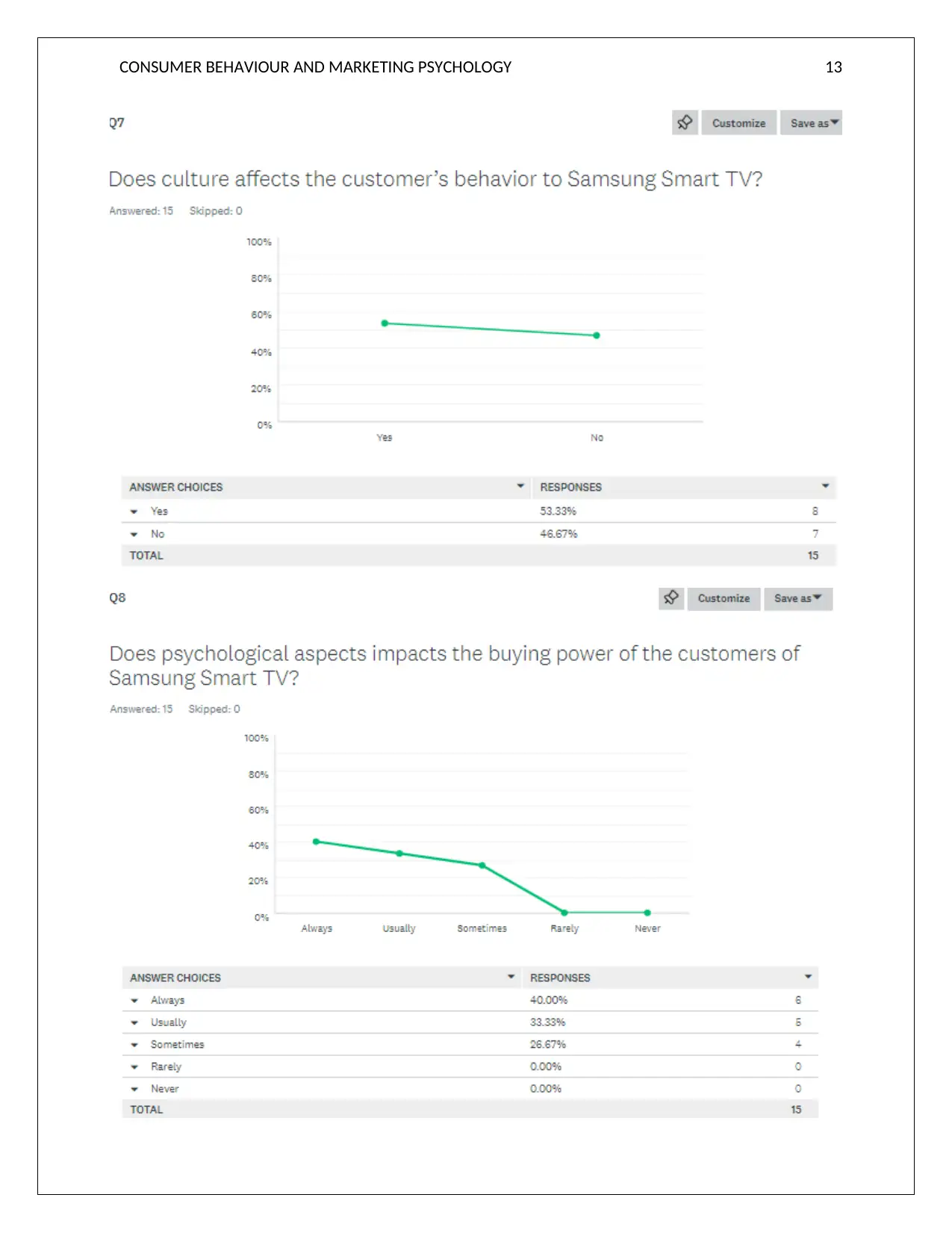
CONSUMER BEHAVIOUR AND MARKETING PSYCHOLOGY 13
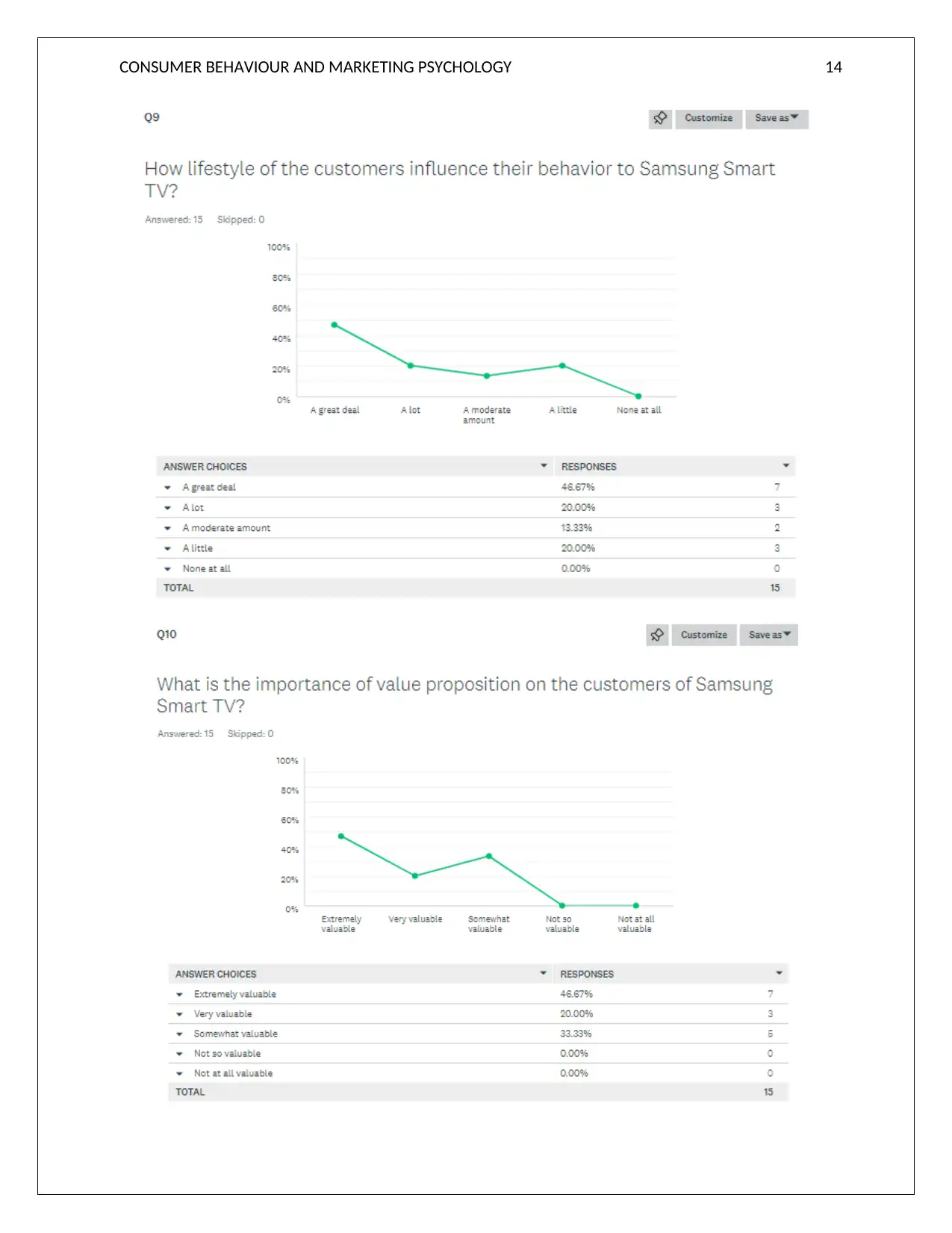
CONSUMER BEHAVIOUR AND MARKETING PSYCHOLOGY 14
1 out of 15
Your All-in-One AI-Powered Toolkit for Academic Success.
+13062052269
info@desklib.com
Available 24*7 on WhatsApp / Email
![[object Object]](/_next/static/media/star-bottom.7253800d.svg)
Unlock your academic potential
© 2024 | Zucol Services PVT LTD | All rights reserved.





